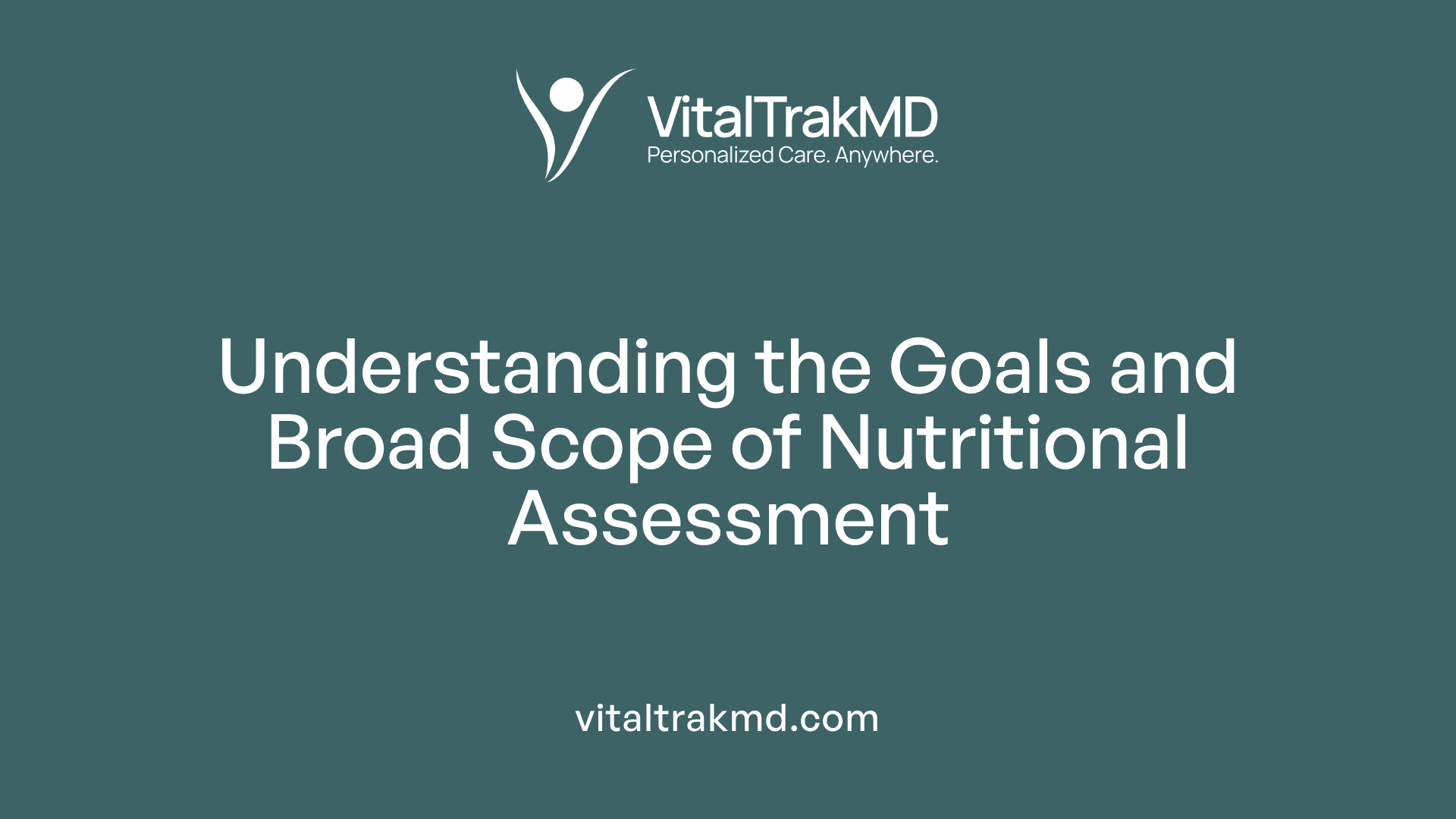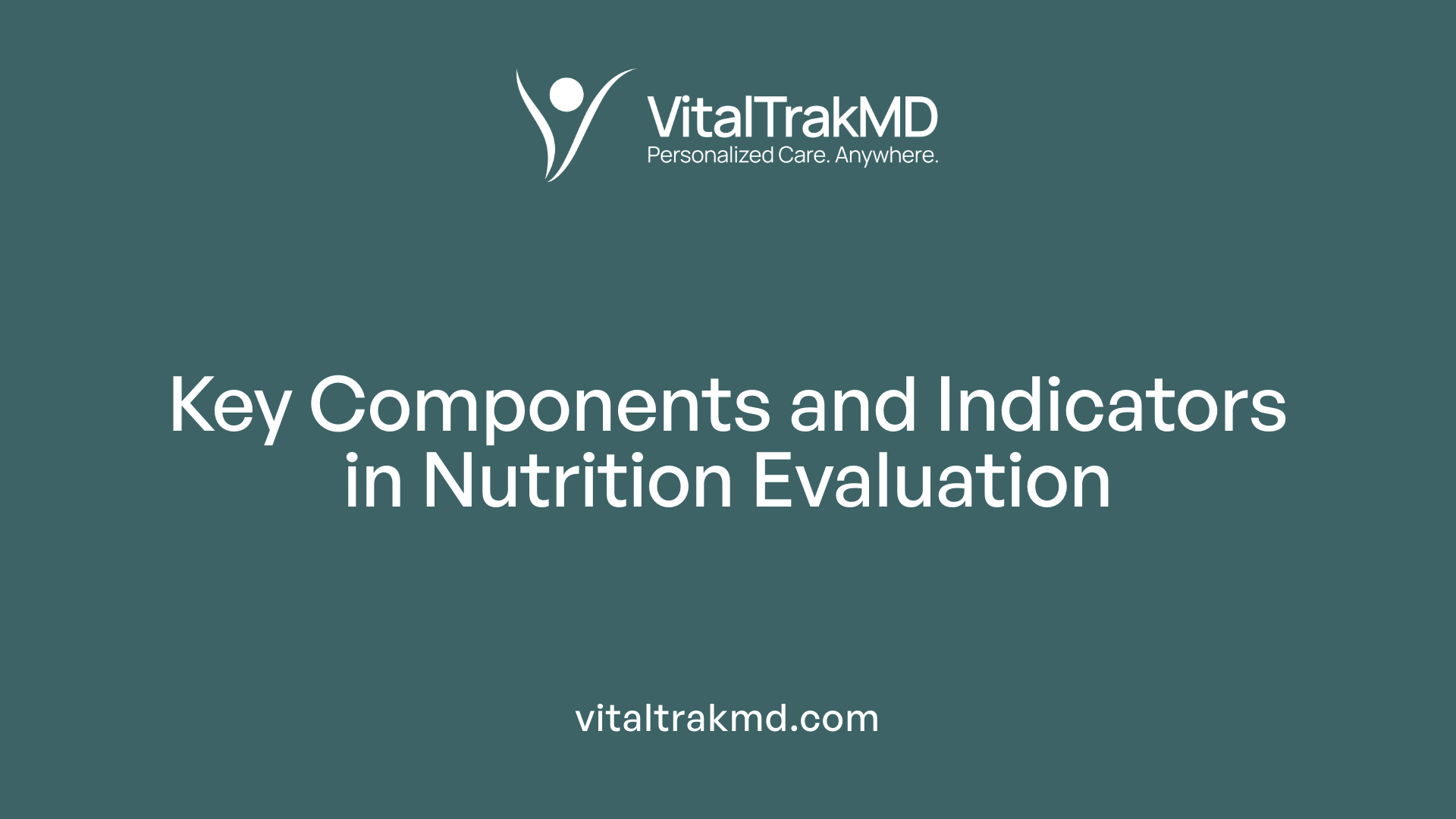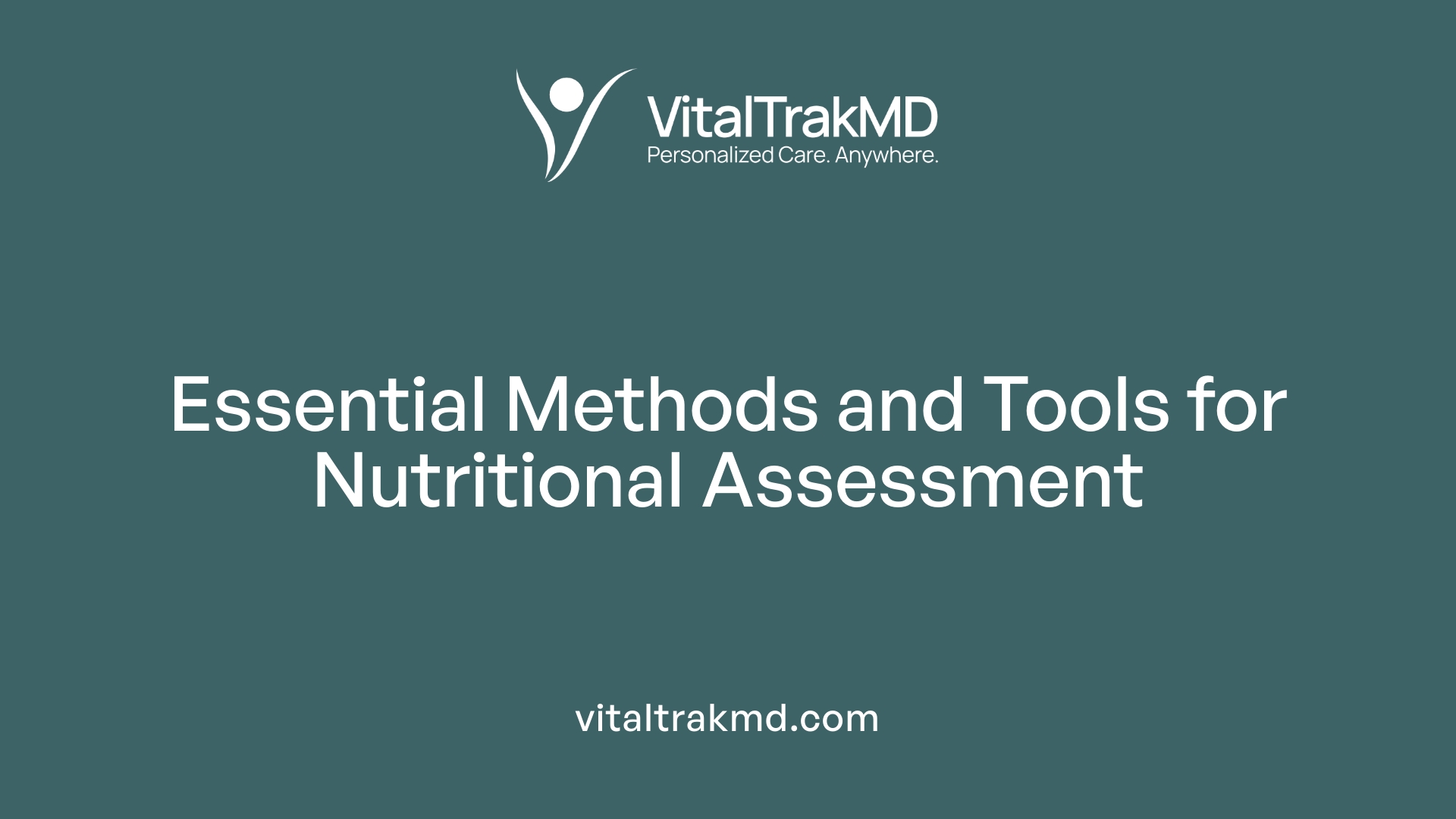How Are Nutritional Needs Assessed in the Program?

Understanding the Fundamentals of Nutritional Needs Assessment
Assessing nutritional needs within health programs is a complex, multifaceted process that plays a pivotal role in identifying deficiencies, guiding interventions, and promoting overall health. This article explores the various components, methods, tools, and procedures employed to evaluate nutritional status effectively across diverse populations and settings.
Objective and Scope of Nutritional Assessment

What are the objectives of nutritional assessment in health programs?
The main goal of nutritional assessment in health programs is to collect, verify, and interpret detailed information about an individual's nutritional status. Healthcare professionals use various data—such as dietary intake, body measurements, biochemical markers, and physical examinations—to build a comprehensive picture of nutritional health.
This process aims to uncover existing nutrition-related problems, understand their root causes, and evaluate their potential health impacts. Identifying issues like malnutrition early allows for timely intervention, preventing further health deterioration.
Nutritional assessment also considers a person’s physiological factors—such as age, gender, and health conditions—as well as psychosocial and environmental influences, including socioeconomic status and access to nutritious foods. This holistic view guides the development of tailored intervention strategies and practical nutrition goals.
Continuous monitoring forms an essential component of the assessment. By regularly evaluating a person's progress, healthcare providers can determine whether interventions are effective or need adjustments.
Overall, the objective is to foster better health outcomes through a systematic and ongoing evaluation process. This helps in early detection, targeted intervention, and the formulation of health programs that effectively address nutritional needs.
Why is early detection of malnutrition important?
Detecting malnutrition early is crucial because it often presents subtle signs in initial stages. Early diagnosis enables prompt intervention, which can prevent severe health complications, growth delays in children, and increased susceptibility to infections.
Timely identification through comprehensive assessment tools like biochemical tests, anthropometric measurements, and clinical signs ensures treatment begins before the condition worsens, supporting recovery and long-term health.
How does nutritional assessment guide intervention and health planning?
Nutritional assessment provides actionable data that inform personalized care plans. By understanding individual nutritional risks and deficiencies, health professionals can recommend specific dietary modifications, supplement use, or lifestyle changes.
Furthermore, assessment highlights disparities and social determinants affecting nutrition, allowing programs to target vulnerable populations effectively. It also helps set realistic, measurable nutrition goals aligned with broader public health objectives.
Is continuous monitoring necessary to evaluate program effectiveness?
Yes, ongoing evaluation is vital. Regular monitoring through follow-up assessments helps detect changes in nutritional status, measure progress toward goals, and assess the success of interventions.
Adjustments can then be made to ensure that nutritional strategies remain relevant and effective, ultimately improving health outcomes and resource utilization.
Tables summarizing assessment components, data collection methods, and tools used in health programs are provided below for quick reference.
| Component | Methodology | Purpose | Examples |
|---|---|---|---|
| Dietary history | 24-hour recall, food frequency questionnaires | Evaluate nutrient intake | Food diaries, interviews |
| Physical exam | Visual inspection, vital signs | Detect signs of malnutrition | Skin, hair, ocular health |
| Anthropometry | Height, weight, BMI | Measure body composition | Skinfold thickness, circumferences |
| Biochemical tests | Blood, urine analysis | Identify deficiencies and inflammation | Albumin, CRP |
| Body composition | BIA, DEXA | Detailed fat and lean mass analysis | Fat percentage, muscle mass |
| Systemic evaluation | Medical history | Understand underlying conditions | Chronic diseases, infections |
By integrating these assessment areas, health programs can develop comprehensive, culturally sensitive, and effective nutrition interventions suited to specific community needs.
Core Components and Indicators in Nutrition Evaluation

What are the key components and indicators evaluated in nutritional assessment?
A thorough nutritional assessment involves examining several crucial aspects to understand an individual’s nutritional health.
One of the primary components is dietary intake evaluation, which assesses what and how much a person eats. Techniques include 24-hour dietary recall, food frequency questionnaires, diet records, and observational methods. These help estimate nutrient and fluid consumption and identify dietary patterns that may contribute to nutritional imbalances.
Anthropometric measurements form another vital part. These include simple measurements such as height, weight, and body mass index (BMI). For a more detailed picture, clinicians measure circumferences of the waist, hips, and limbs, as well as skinfold thickness, to estimate body fat and muscle mass. Advanced assessments like bioelectrical impedance analysis (BIA) and dual-energy X-ray absorptiometry (DEXA) provide comprehensive data on body composition, differentiating between fat mass, lean tissue, and bone density.
Laboratory tests or biochemical markers are essential for detecting deficiencies or excesses of nutrients. Common markers include serum albumin, prealbumin, and transferrin, which reflect protein status. Additional tests measure micronutrient levels such as vitamin D, iron, and zinc, along with inflammatory markers like C-reactive protein (CRP), to detect ongoing inflammation that might affect nutritional health.
Clinical signs observed during physical examination provide visual and physiological clues. These signs include muscle wasting, skin changes, hair quality, oral health, and joint or extremity abnormalities. The physical exam helps confirm laboratory findings and highlights subtle or advanced malnutrition or specific nutrient deficiencies.
Finally, evaluating socioeconomic and environmental factors enriches the overall assessment. Factors such as food security, socioeconomic status, access to healthcare, and environmental influences significantly impact nutritional status. Understanding these elements helps healthcare providers create tailored, effective intervention plans.
Collectively, these components form a comprehensive framework, allowing clinicians to accurately identify nutrition-related problems, establish diagnoses, and develop appropriate, individualized nutrition interventions.
Methodologies and Tools in Nutritional Evaluation

What are the main methods used in nutritional assessment?
Nutritional assessment employs a variety of approaches to comprehensively evaluate an individual's nutritional health. The primary methods include clinical evaluation, dietary assessment, anthropometric measurements, biochemical testing, and physical examinations.
Clinical evaluation involves gathering detailed medical history and symptom reports, including weight changes, signs of malnutrition, medication use, lifestyle factors, and socioeconomic status. This helps identify underlying health issues related to nutrition.
Dietary assessment is conducted through various tools such as 24-hour dietary recalls, food frequency questionnaires, food diaries, and direct observation. These methods estimate current nutrient and fluid intake, providing insights into dietary habits and potential deficiencies.
Anthropometric measurements are physical assessments that include recording height, weight, BMI, circumferences, and skinfold thickness. For more detailed insights into body composition, techniques like bioelectrical impedance analysis (BIA) and dual-energy X-ray absorptiometry (DEXA) are utilized, offering precise information about fat and lean mass.
Laboratory and biochemical tests analyze blood, urine, or tissue samples to measure nutrient levels (such as vitamins and minerals), protein status, and markers of inflammation like CRP. These tests are invaluable in detecting deficiencies early, often before clinical symptoms appear.
Lastly, physical examinations focus on visual and tactile signs of malnutrition, including examination of eyes, skin, hair, nails, and oral cavity to detect morphological and functional changes associated with nutritional imbalances.
Together, these methodologies form a multi-faceted approach that allows healthcare professionals to accurately assess nutritional status, identify risks, and plan appropriate interventions. No single method provides a complete picture; instead, an integrated evaluation ensures a thorough understanding of an individual’s nutrition-related health.
Assessing Nutritional Needs and Risks in Populations and Individuals
An effective evaluation of nutritional needs involves a multi-layered approach that considers the unique characteristics of different population groups, such as children, the elderly, and pregnant women. Healthcare professionals use specialized assessment methods tailored to these groups, including growth charts for children, body composition analysis for older adults, and pregnancy-specific evaluations.
In emergency settings, rapid assessment tools like the Mid-Upper Arm Circumference (MUAC) and bilateral edema screening are invaluable. These simple, quick tests help identify children at risk of malnutrition and facilitate immediate intervention, especially when time and resources are limited.
Screening tools such as the DETERMINE Your Nutritional Health checklist are widely used to assess nutritional risk in community populations. This questionnaire evaluates factors like illness, social isolation, economic hardship, and eating habits, helping to categorize individuals according to their risk levels. Similarly, clinical tools like the NRS-2002 are employed in hospital settings to identify patients needing nutritional support.
Gathering comprehensive data from diverse sources—medical records, dietary histories, physical examinations, laboratory tests, and sociocultural information—is crucial for personalized nutritional planning. This data collection ensures that interventions are well-targeted and effective.
Identifying vulnerable groups and high-priority areas allows health professionals to streamline resources and tailor interventions. Populations facing socio-economic hardships, chronic illnesses, or specific age-related needs often require focused attention. Effective assessment not only pinpoints current deficiencies but also anticipates future risks, guiding preventive strategies.
| Assessment Method | Population Focus | Main Use | Additional Notes |
|---|---|---|---|
| Dietary Evaluation | All | Determines nutrient intake | Food diaries, recall, questionnaires |
| Anthropometric Measurements | Children, elderly, at-risk groups | Body size, composition | BMI, MUAC, skinfolds |
| Laboratory Tests | All | Nutritive status & deficiencies | Blood nutrient levels, biomarkers |
| Rapid Tools | Children | Screening for malnutrition | MUAC, edema screening |
| Screening Questionnaires | General community | Risk stratification | DETERMINE, NRS-2002 |
Guidelines and Standards for Conducting Nutritional Assessments
When performing a nutritional assessment, healthcare professionals adhere to well-established guidelines and standards to ensure accuracy and consistency. These procedures involve validated methods to evaluate multiple aspects of nutritional health, including dietary intake, physical measurements, biochemical markers, and clinical signs.
A comprehensive approach requires following standardized protocols, such as those recommended by expert organizations like the American Society for Parenteral and Enteral Nutrition (ASPEN). These include systematic collection of clinical history, physical examination, and laboratory tests. It’s important to utilize multiple methods, such as dietary recall, anthropometry, and biochemistry, and compare findings against reference norms and international guidelines.
The process should involve a multidisciplinary team, including physicians, dietitians, nurses, and lab technicians. This team collaborates to interpret data accurately, formulate diagnoses, and develop effective intervention plans.
Ethical considerations are crucial; professionals must ensure data integrity, respect patient confidentiality, and obtain informed consent when necessary. Data should be reliable, gathered through validated tools and methods, and documented meticulously.
To support ongoing care, reassessment and continuous evaluation are vital. Regular monitoring helps track progress, adjust interventions, and adapt to changes in nutritional status. Employing interoperable data standards, such as LOINC and HL7 FHIR, enhances communication and data sharing across different healthcare settings.
Overall, aligning practice with these guidelines ensures comprehensive, ethical, and effective nutritional assessments that inform optimal patient care and health outcomes.
Integrating Nutritional Assessment into Programmes for Better Health Outcomes
Effective evaluation of nutritional needs is a cornerstone of health programs, underscoring the importance of comprehensive, accurate, and tailored assessment procedures. Employing a combination of clinical, dietary, anthropometric, biochemical, and social data, supported by validated tools and standardized protocols, ensures a holistic understanding of an individual's or population's nutritional status. Collaborative efforts among multidisciplinary teams and continuous monitoring allow for timely, appropriate interventions that promote health, prevent disease, and enhance quality of life. As nutritional science advances and assessment methodologies improve, programs must adapt to integrate innovative approaches, utilize emerging tools, and uphold ethical standards, ultimately fostering resilience and well-being in diverse communities.
References
- Nutritional Assessment - StatPearls - NCBI Bookshelf
- Nutrition Assessment - eatrightPRO.org
- [PDF] DETERMINE Your Nutritional Health
- Nutrition Assessment - an overview | ScienceDirect Topics
- Nutrition Monitoring and Evaluation - eatrightPRO.org
- Nutrition needs assessment - UNHCR | Emergency Handbook
- Introduction to types and purpose of nutrition needs assessments
- Effective Needs Assessment for Community Nutrition Programs
- Nutrient Recommendations and Databases
Recent articles
Want to Feel Better and Live Healthier?
Join hundreds of patients taking control of their health with personalized care that fits their life – not the other way around.
Rated 4.8/5 by 32+ customers







